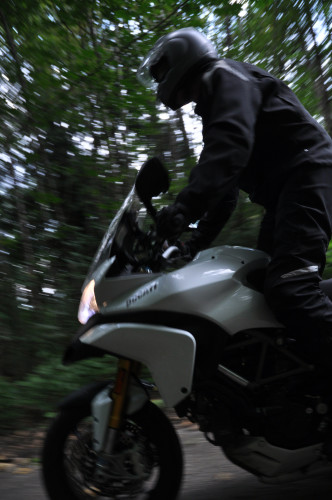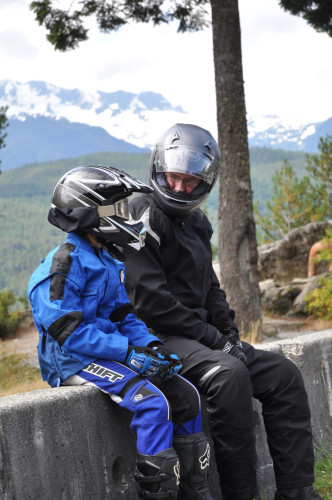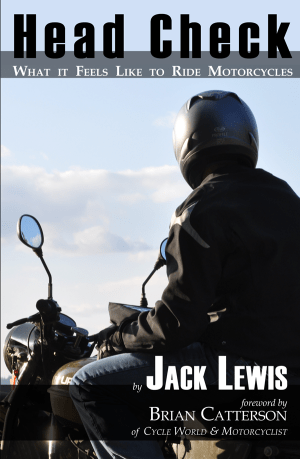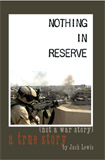This column is addressed to combat veterans. If you’re not in that group, turn the page now. Nothing here will be explained to your satisfaction.
Listen up, people. You need to stop using my favorite sport to decimate my only respectable peer group.
Picture of a soldier ready to die, as outlined on the U.S. Army Combined Arms Center safety blog: male, grade E-4 or E-5, 20 to 24 years old. Redeployed for less than six months, SGT Snuffy crashes his high-speed-low-drag sportbike and sounds off “dead” at his next formation.
It’s so safe here in the Land of the Free that it feels wrong all the time, and some of us go looking for risk just to remember what it feels like to punch the Reaper in the beak. As my former gunner said the other night, “It’s like, what’re ya gonna do — kill me?” He rides a 2009 GSXR 750 with a pipe and a Power Commander.
We already walked through the world’s worst neighborhoods with bullseyes painted on our chests and drove every single highway to Hell in dog-slow trucks with hillbilly armor. We look twice at things most Americans never even notice. We check the pattern. We watch for movement.
The only enemy capable of putting us down is… us.
There was a different guy in my detachment. We’ll call him “Hi-Speed.” Hi-Speed was impatient with our training. He thought it was weak.
The rest of us just held Hi-Speed back. Hell, all of USASOC held him back, especially when it issued us M16A2 “muskets” instead of carbines. Then one day at Ft. Bragg, our spankin’ new M4s showed up, complete with ACOGs. Hi-Speed “got wood” (yeah, I’m quoting him), but Hi-Speed was ate up like a soup sandwich.
He shot our one and only bolo. Turned out it wasn’t about the Cool Guy rifle after all. It was about training. It was about keeping your shot group tight.
If you redeploy, throw your SRB down on a hyperbike and set out to see how fast you can cane it down the road, you’re likely to go down like a sack of hammers and crashing is messed up. Crashing is a No-Go.
Big Boy Rules apply. Walk into a motorcycle dealership with a fistful of folding green freedom and they won’t talk you down from that Hayabusa or Streetfighter — not in this economy. Their job is to sell bikes, not take care of the troops. Yet those bikes deserve the same respect, training and professional awareness as a weapon — and you never got issued weapons without serious training.
The most at-risk riders in the military community are risk-tolerant, adrenaline-juicing combat professionals — airborne, jarheads, PJs and door kickers of every persuasion. You know who you are. Guys with wings and tabs and combat badges. Cocky guys who know some stuff.
CQB and CLS training doesn’t make you a better rider, and being a vet might just make you a worse one. Yeah, I went there. You can be the best Mk 19 gunner who ever walked, but it won’t keep your cheek off the pavement if you outride your motorcycle skill set.
You’re either the best or you’re not. Dying on bikes more easily than squishy civilians is not evidence of being “the best.”
The Joint Service Safety Council identified motorcycle safety and training as the number one non-combat safety concern across all services. Why? Because the Insurance Institute for Highway Safety estimates annual U.S. rider fatalities at around 7.5 per 10,000 — but for the Marine Corps, that rate runs almost 10 in 10,000. In 2008, we lost more Marines to motorcycle accidents than to hajji action.
Unacceptable.
•••
An old cadence runs like this: If I die in a combat zone, box me up and ship me home. Pin my medals upon my chest. Tell my mama I did my best!
There are no medals for sliding under an SUV and crushing your chest, none for smacking a Jersey barrier and bruising the one and only brain you’ll ever get issued. Pending a line of duty investigation, you could even be denied your medical benefits or death gratuity if you weren’t properly trained and equipped. Will they tell your mama you did your best, or just quietly hand her a hospital bill alongside the folded flag?
Most commands have long prohibited riding on- or off-post without passing an approved motorcycle safety course. Rider courses are FREE for active duty, so go sign up if you’re still in. Bring a protective jacket, retro-reflective vest, quality helmet, solid boots and riding gloves or they’ll send you back to try again later.
Already know it all? Try a higher-level course, tough guy. Some army posts and all naval bases now require MSF’s Military Sportbike RiderCourse if you want to ride a sporting machine. And you do want to ride a sportbike, even if you don’t know that yet. As Lawrence of Arabia put it, “A skittish motor-bike with a touch of blood in it is better than all the riding animals on earth.”
The army even springs for virtual reality immersion courses. Emplaced at Camp As Sayliyah, Qatar, the Honda Safe Motorcyclist Awareness and Recognition Trainer (SMARTrainer), a kind of flight simulator for bikes, helps prepare redeploying soldiers for the realities of Stateside riding in mixed environments.
CONUS bases host motorcycle safety rallies like Ft. Hood’s Phantom Thunder and Ft. Gillem’s First Army Commander Safety Ride. The army also cribbed a rider mentoring program from the air force.
Former 500cc world champion and superbike guru Kevin Schwantz has become a Pentagon spokesman for rider training, and 2006 MotoGP champ Nicky Hayden films military safety spots funded by the American Motorcycle Industry Council. The services are spending money, forging alliances and working hard to drive down off-duty accidents, so do your part.
What about prior service road casualties? Nobody tracks the number of skitchy vets who pop smoke on bikes. Freshly released from General Order Number One with money to burn, adjustment issues and no chain of command to shove the cork back in the bottle, we don’t need no stinkin’ safety course. Hell, we can ride better drunk than civilians could ride on their best freakin’ day. We got… we got situational awareness! And fine, fast bikes.
To crib from Lance Armstrong, it’s not about the bike. What kind of rider are you? What kind of man are you?
Something different than you were before you got shot at, blown up, mortared, fragged. Traumatic brain injuries and PTSD etch permanent physical changes into your thinking apparatus. If you have trouble remembering things, lose your way sometimes or your temper a lot, fight with strangers or stay on edge all the time, don’t try to work it out at 130 mph on the causeway. Go see someone at the VA and get in touch with your inner amygdala. The counselors there know a few things that you need to learn. And practice.
While you’re at it, take a rider training course. Practice that, too. Ride more, suck less.
•••
I’m no holier than thou. Every stupid thing you could do on a motorcycle, I’ve probably done twice. I’ve ridden like a jackass on public roads, failed to PMCS my equipment, gone “just around the block” for a few hours with no pro gear because it was hot out. Like hot is some big deal…
I’ve ridden twisted, too. Fast and hard. I didn’t care what happened, and I liked not caring. I wanted to ride so blindingly fast into the night that it would all drop away behind me and I would be clean again, and free. I couldn’t hurt anyone but myself so it was okay…
Don’t do that. It’s not the way home. Someone I care for very much asked me not to do it anymore. She reminded me that I would hurt my people that way and maybe someone else’s people, too. For that reminder, I bless her every day.
Someone cares for you, too — maybe someone you haven’t met yet. Don’t blow that chance. You have a duty to the future.
Find a racetrack or a superbike school, and do your need for speed right. Go ride up the canyon with your buddies without setting the interstate lap record. Get a dirt bike and hit the desert races, or screw on supermoto rims and scare yourself silly skittering around paved courses. Don’t use the public road to show everybody what a bad motor scooter you can be.
We already know what a badass you are. Thank you for being that when you were called — we couldn’t have had anyone better. Thank you for not being that around my family, and for not using my favorite sport to take yourself out of the gene pool.
When the best of Americans smear themselves into wet, red stripes it doesn’t just embarrass us. It defeats us, and I hate losing. I served with winners and earned the right to ride with you. So vets, tighten up your shot group.
Going out in a bright white bang, still young enough to make a good looking corpse, may sound more honorable than slow death in suburbia, surrounded by peace-fattened civilians, but you know that “slow death” you’re worried about? It’s called “life.”
You earned some.
This article first ran in Motorcyclist magazine in September 2009. It has subsequently been used in several safety programs around the country and is included in Head Check: What it Feels Like to Ride Motorcycles.
This piece may be reproduced without charge for non-commercial promotion of motorcycle safety, so long as this copyright notice remains intact: © 2009 Jack Lewis and a link back to this blog is included where possible.
For commercial use, please contact Jack.



 "Jack Lewis takes the overall literary crown with his new book...there’s a lot more to Lewis’s work than what it feels like to ride motorcycles.” — Ultimate Motorcycling
"Jack Lewis takes the overall literary crown with his new book...there’s a lot more to Lewis’s work than what it feels like to ride motorcycles.” — Ultimate Motorcycling
 "Insightful and from the heart ... a driven and much recommended look into the mind and conflict of the next generation of war veterans. " — Midwest Book Review (Reviewer's Choice)
"Insightful and from the heart ... a driven and much recommended look into the mind and conflict of the next generation of war veterans. " — Midwest Book Review (Reviewer's Choice)